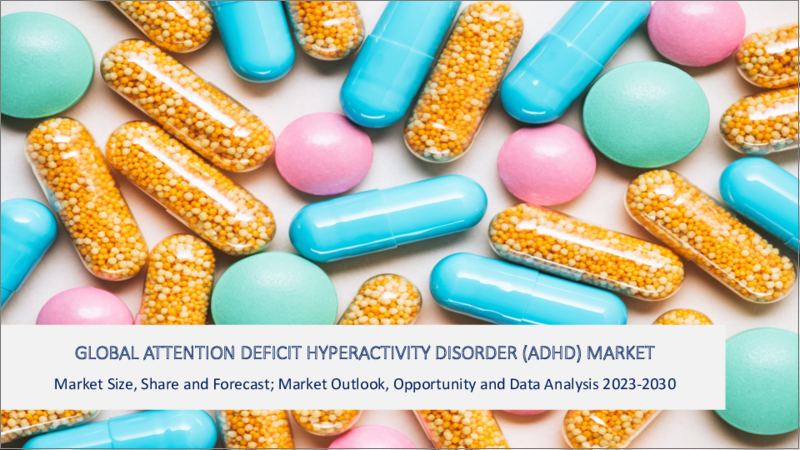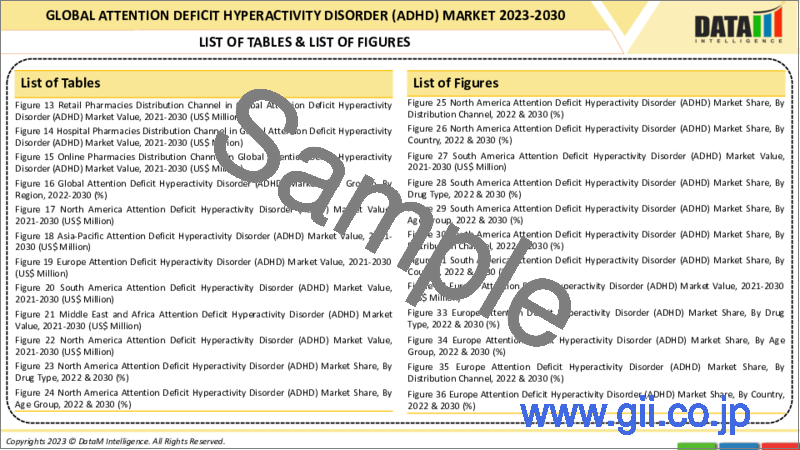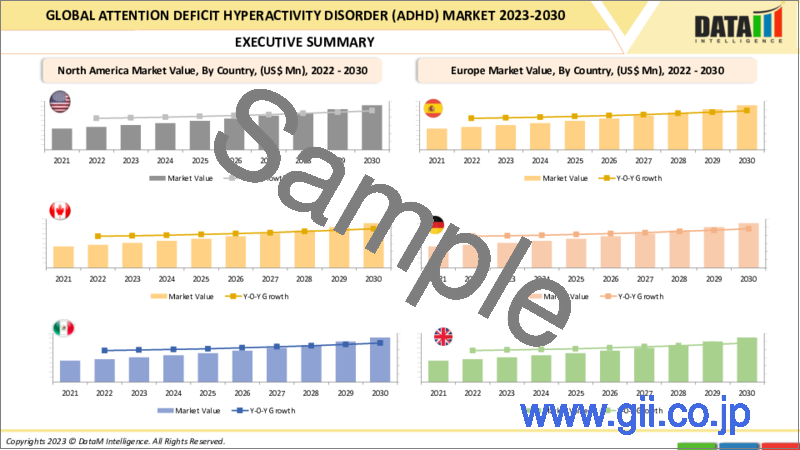|
|
市場調査レポート
商品コード
1304542
注意欠陥多動性障害(ADHD)の世界市場-2023年~2030年Global Attention Deficit Hyperactivity Disorder (ADHD) Market - 2023-2030 |
||||||
カスタマイズ可能
適宜更新あり
|
|||||||
| 注意欠陥多動性障害(ADHD)の世界市場-2023年~2030年 |
|
出版日: 2023年07月07日
発行: DataM Intelligence
ページ情報: 英文 195 Pages
納期: 即日から翌営業日
|
- 全表示
- 概要
- 目次
市場概要
世界の注意欠陥多動性障害(ADHD)市場は、2022年に157億米ドルに達し、2030年には219億米ドルに達すると予測されています。世界の注意欠陥多動性障害市場は、予測期間2023-2030年にCAGR 4.3%を示すと予測されます。
最近の市場動向としては、非刺激薬へのシフト、デジタルヘルスソリューションの拡大、併用療法への注目の高まりなどが挙げられます。世界の注意欠陥多動性障害市場は近年継続的に拡大しています。注意欠陥多動性障害は、子供から大人までが罹患する神経疾患です。ADHDは、持続的な不注意、多動性、衝動性によって定義され、日常生活機能と生活の質を損なう可能性があります。
世界の注意欠陥多動性障害の市場範囲は、注意欠陥多動性障害の市場シェアの使用量を増加させている刺激薬や非刺激薬などの薬剤の種類を包含するコンポーネントで構成されています。注意欠陥多動性障害の世界市場は、ADHDの有病率の増加、社会的認知の高まり、研究開発の重視の高まりなどの要因により拡大しています。
市場力学
効果的な治療法に対する需要の増加が注意欠陥多動性障害(ADHD)市場の成長を牽引
世界のADHD市場は、効果的な治療法や医薬品に対する需要の高まりによって牽引されています。刺激薬は長い間ADHDの治療薬として選ばれており、医薬品市場における優位性がその有効性を証明しています。メチルフェニデート、アンフェタミン塩、デキストロアンフェタミンなどのこれらの医薬品は、脳内の特定の神経伝達物質のレベルを高め、集中力の向上と衝動性の低下をもたらします。
さらに、Stratteraのような非刺激薬の人気が高まっていることから、悪影響を最小限に抑えながら有効性をもたらす新しい治療法の必要性が強調されています。その良好な安全性プロファイルから、非刺激性医薬品は患者やヘルスケア専門家の間で認知されています。例えば、2022年3月、Xelstrym(デキストロアンフェタミン)は、成人および6歳以上の子供のADHDを治療するためのアンフェタミンパッチとして初めてFDAの承認を受けた。これにより、予測期間中の市場を牽引します。
認知度の向上が世界の注意欠陥多動性障害(ADHD)市場の主要促進要因
医療従事者や一般市民の間でADHDに対する認識が高まっていることは、ADHD分野における市場拡大の主な要因です。この病気に対する認識が高まり、早期発見・早期治療につながっています。米国保健社会福祉省と欧州ADHD同盟は、より良い治療の選択肢を推進し、ADHD患者の生活の質の向上に取り組む2つの組織です。
CDCは州やパートナー団体と協力し、ADHDの行動療法を支援する意識を高め、ベストプラクティスを特定しています。専門家は、6歳未満の子どものADHDには、薬物療法を行う前に行動療法を行うことを勧めています。このように、この疾患に関する認知度の向上は、予測期間中の市場を牽引すると思われます。
非刺激性ADHD治療薬の入手可能性が限られていることは、市場の成長を妨げると思われます
非刺激性ADHD治療薬の希少性がADHD市場の妨げとなります。刺激薬が市場を独占する一方で、アトモキセチン(Strattera)のような非刺激薬の選択肢に対する需要は増加しています。しかし、こうした非刺激薬の入手可能性は限られているため、ADHD患者のさまざまな治療ニーズを満たすことは困難です。この制約は、治療の選択肢を制限し、おそらくADHD患者集団の一部に十分なサービスを提供しないことによって、市場の成長を阻害します。
COVID-19影響分析
COVID-19のパンデミックと世界各国での封鎖により、あらゆる業種の企業の財務の健全性が影響を受けています。そのため、COVID-19公衆衛生緊急事態の期間中、米国食品医薬品局(FDA)は、スポンサーと研究者を支援し、試験参加者の安全を確保し、適正臨床実施基準(GCP)を遵守し、試験の完全性に対するリスクを最小限に抑えるための一般的な考慮事項を含むガイドラインを発表しました。
ロシア・ウクライナ紛争影響分析
ロシアとウクライナの紛争は、ADHDの世界市場に様々な影響を及ぼす可能性があります。ADHD治療薬のサプライチェーンの混乱、経済の状況、ヘルスケアシステムの問題、人々への心理的影響など、考慮すべき本質的な事柄がいくつかあります。
これらの要素は、不足の可能性、さまざまな需要、ヘルスケアサービスへのアクセスの制限、ADHDの有病率の上昇をもたらす可能性があります。状況を注視し、混乱を防ぎ、ADHD治療薬へのアクセスを保証するために必要な措置を講じることが不可欠です。
目次
第1章 調査手法と調査範囲
第2章 定義と概要
第3章 エグゼクティブサマリー
第4章 市場力学
- 影響要因
- 促進要因
- 効果的な治療法に対する需要の増加
- 意識の高まり
- 抑制要因
- 非刺激性ADHD治療薬の入手可能性の制限
- 影響分析
- 促進要因
第5章 産業分析
- ポーターの5フォース分析
- サプライチェーン分析
- 価格分析
- 規制分析
第6章 COVID-19分析
第7章 薬剤タイプ別
- 刺激薬
- 非刺激薬
第8章 年齢層別
- 小児および青年
- 成人
第9章 流通チャネル別
- 小売薬局
- 病院薬局
第10章 地域別
- 北米
- 米国
- カナダ
- メキシコ
- 欧州
- ドイツ
- 英国
- フランス
- スペイン
- イタリア
- その他欧州
- 南米
- チャンネル
- ブラジル
- アルゼンチン
- その他南米
- チャンネル
- アジア太平洋
- 中国
- インド
- 日本
- オーストラリア
- その他アジア太平洋地域
- 中東・アフリカ
第11章 競合情勢
- 競合シナリオ
- 市況/シェア分析
- M&A分析
第12章 企業プロファイル
- Supernus Pharmaceuticals, Inc.
- 会社概要
- 製品ポートフォリオと説明
- 財務概要
- 主な発展
- Pfizer Inc
- Novartis AG
- Eli Lilly and Company
- GlaxoSmithKline PLC
- Mallinckrodt Pharmaceuticals
- Johnson & Johnson
- Hisamitsu Pharmaceutical Co., Inc.,
- Chongqing Fujin Biology Medical Company
- Purdue Pharma LP
第13章 付録
Market Overview
The Global Attention Deficit Hyperactivity Disorder (ADHD) Market reached US$ 15.7 billion in 2022 and is projected to witness lucrative growth by reaching up to US$ 21.9 billion by 2030. The Global Attention Deficit Hyperactivity Disorder Market is expected to exhibit a CAGR 4.3% during the forecast period 2023-2030.
Recent market trends include the shift towards non-stimulant medications, the expansion of digital health solutions, and a growing focus on combination therapies. The Global Attention Deficit Hyperactivity Disorder Market has expanded continuously in recent years. It is a neurological condition that affects both children and adults. ADHD is defined by persistent inattention, hyperactivity, and impulsivity, which can impair everyday functioning and quality of life.
The global attention deficit hyperactivity disorder market scope comprises components encompassing drug types such as stimulant drugs and non-stimulant drugs, which has increased usage of attention deficit hyperactivity disorder market share. The global market for attention deficit hyperactivity disorder is expanding as a result of factors including the increasing prevalence of ADHD, growing public awareness, and growing emphasis on R&D.
Market Dynamics
An Increase in Demand for Effective Treatments Drive the Growth of the Attention Deficit Hyperactivity Disorder Market
The global ADHD market is driven by rising demand for effective treatments and drugs. Stimulant medicines have long been the treatment of choice for ADHD, and their dominance in the pharmaceutical market attests to their effectiveness. These drugs, such as methylphenidate, amphetamine salts, and dextroamphetamine, boost the levels of particular neurotransmitters in the brain, resulting in improved focus and less impulsivity.
Furthermore, the increasing popularity of non-stimulant drugs such as Strattera emphasizes the need for new treatment choices that provide efficacy while minimizing negative effects. Because of their favorable safety profile, non stimulant medicines have gained recognition among patients and healthcare professionals. For instance, in March 2022, Xelstrym (dextroamphetamine) received the first FDA-approved amphetamine patch to treat ADHD in adults and kids above six. Thereby driving the market over the forecast period.
Growing Awareness is the Major Driver in the Global Attention Deficit Hyperactivity Disorder Market
Growing ADHD awareness among healthcare professionals and the general public is a major driver of market expansion in the ADHD sector. There has been a greater awareness of the illness, resulting in earlier identification and treatments. The US Department of Health and Human Services and the European ADHD Alliance are two organizations that promote better treatment options and work to improve the quality of life for people with ADHD.
The CDC collaborates with states and partner organizations to raise awareness and identify best practices supporting ADHD behavior therapy. Experts advise treating ADHD in children under the age of six with behavior therapy before using medication. Thus, increasing awareness about the disorder will drive the market over the forecast period.
The Limited Availability of Non-Stimulant ADHD drugs will Hamper the Growth of the Market.
The scarcity of non-stimulant ADHD medications hampers the ADHD market. While stimulant drugs dominate the market, demand for non-stimulant options such as atomoxetine (Strattera) is increasing. However, the limited availability of these non-stimulant medicines makes satisfying the different treatment needs of people with ADHD difficult. This constraint stifles market growth by limiting treatment alternatives and perhaps underserving a section of the ADHD patient population.
COVID-19 Impact Analysis
The financial health of companies across all industries has been impacted by the COVID-19 pandemic and lockdown in numerous nations worldwide. Therefore, for the period of the COVID-19 public health emergency, the U.S. Food and Drug Administration (FDA) issued guidelines that include general considerations to aid sponsors and researchers, ensuring the safety of trial participants, adhering to good clinical practice (GCP), and minimizing risks to trial integrity.
Russia-Ukraine War Impact Analysis
The conflict between Russia and Ukraine can potentially have an array of effects on the global market for ADHD. There are several essential things to consider, including disruptions in the supply chains for ADHD medications, the state of the economy, problems with the healthcare system, and the psychological effects on people.
These elements may result in possible shortages, varying demands, restricted access to healthcare services, and a rise in the prevalence of ADHD. It will be essential to monitor the situation and take the necessary steps to prevent disruptions and guarantee that ADHD medicines remain accessible.
Segment Analysis
The Global Attention Deficit Hyperactivity Disorder Market is segmented based on drug type, age group, distribution channel, and region.
Retail Pharmacies Distribution Channel Segment Accounts for 61.2% of Market Share Owing to Ease of Access
The retail pharmacy segment dominates the ADHD industry since it is the primary point of purchase for patients seeking ADHD drugs and therapies. This dominance can be explained by the prevalence of outpatient treatment for ADHD patients.
Furthermore, there has been an increased emphasis on patient care efforts such as Greenway Medical Technologies, which provides consumers with personal Electronic Health Records (EHRs). These EHRs assist patients in keeping track of their drug history and receiving basic treatment, which contributes to the importance of retail pharmacies in the ADHD industry.
Geographical Analysis
North America Accounted for Approximately 62.4% of the Market Share Owing to the Increasing Prevalence of ADHD.
North America dominates the Global ADHD Market because of factors such as a higher prevalence of ADHD, greater awareness, early diagnosis, and well-established healthcare infrastructure. The region has a huge patient pool and favorable reimbursement regulations encourage the market's growth. Along with the U.S., Canada is also a country that has a higher prevalence of ADHD.
According to the Centre for ADHD Awareness, Canada (CADDAC), ADHD, a prevalent neurodevelopmental disorder in Canada, affects many of the population. ADHD affects around 4-6% of adults and 5-7% of children in Canada, totaling approximately 1.8 million Canadians. This indicates that about 1 in every 21 Canadians has been diagnosed with the disorder. Therefore, owing to the growing prevalence of ADHD in North America to dominate the market over the forecast period.
Competitive Landscape
The major global players in the attention deficit hyperactivity disorder market include: Supernus Pharmaceuticals, Inc., Pfizer Inc, Novartis AG, Eli Lilly and Company, GlaxoSmithKline PLC, Mallinckrodt Pharmaceuticals, Johnson & Johnson, Hisamitsu Pharmaceutical Co., Inc., Chongqing Fujin Biology Medical Company, Purdue Pharma LP, and among others.
Why Purchase the Report?
- To visualize the Global Attention Deficit Hyperactivity Disorder Market segmentation based on drug type, age group, distribution channel, and region and understand key commercial assets and players.
- Identify commercial opportunities by analyzing trends and co-development.
- Excel data sheet with numerous attention deficit hyperactivity disorder market-level data points with all segments.
- PDF report consists of a comprehensive analysis after exhaustive qualitative interviews and an in-depth study.
- Product mapping is available as Excel, consisting of key products of all the major players.
The Global Attention Deficit Hyperactivity Disorder Market Report Would Provide Approximately 53 Tables, 54 Figures And 195 pages.
Target Audience 2023
- Manufacturers/ Buyers
- Industry Investors/Investment Bankers
- Research Professionals
- Emerging Companies
Table of Contents
1. Methodology and Scope
- 1.1. Research Methodology
- 1.2. Research Objective and Scope of the Report
2. Definition and Overview
3. Executive Summary
- 3.1. Snippet by Drug Type
- 3.2. Snippet by Age Group
- 3.3. Snippet by Distribution Channel
- 3.4. Snippet by Region
4. Dynamics
- 4.1. Impacting Factors
- 4.1.1. Drivers
- 4.1.1.1. An Increase in Demand for Effective Treatments
- 4.1.1.2. Growing Awareness
- 4.1.2. Restraints
- 4.1.2.1. The Limited Availability of Non-Stimulant ADHD drugs
- 4.1.3. Impact Analysis
- 4.1.1. Drivers
5. Industry Analysis
- 5.1. Porter's 5 Forces Analysis
- 5.2. Supply Chain Analysis
- 5.3. Pricing Analysis
- 5.4. Regulatory Analysis
6. COVID-19 Analysis
- 6.1. Analysis of COVID-19
- 6.1.1. Scenario Before COVID-19
- 6.1.2. Scenario During COVID-19
- 6.1.3. Scenario Post COVID-19
- 6.2. Pricing Dynamics Amid COVID-19
- 6.3. Demand-Supply Spectrum
- 6.4. Government Initiatives Related to the Market During Pandemic
- 6.5. Manufacturers Strategic Initiatives
- 6.6. Conclusion
7. By Drug Type
- 7.1. Introduction
- 7.1.1. Market Size Analysis and Y-o-Y Growth Analysis (%), By Drug Type
- 7.1.2. Market Attractiveness Index, By Drug Type
- 7.2. Stimulant*
- 7.2.1. Introduction
- 7.2.2. Market Size Analysis and Y-o-Y Growth Analysis (%)
- 7.3. Non-stimulant
8. By Age Group
- 8.1. Introduction
- 8.1.1. Market Size Analysis and Y-o-Y Growth Analysis (%), By Age Group
- 8.1.2. Market Attractiveness Index, By Age Group
- 8.2. Pediatric and Adolescents*
- 8.2.1. Introduction
- 8.2.2. Market Size Analysis and Y-o-Y Growth Analysis (%)
- 8.3. Adults
9. By Distribution Channel
- 9.1. Introduction
- 9.1.1. Market Size Analysis and Y-o-Y Growth Analysis (%), By Distribution Channel
- 9.1.2. Market Attractiveness Index, By Distribution Channel
- 9.2. Retail Pharmacies*
- 9.2.1. Introduction
- 9.2.2. Market Size Analysis and Y-o-Y Growth Analysis (%)
- 9.3. Hospital Pharmacies
10. By Region
- 10.1. Introduction
- 10.1.1. Market Size Analysis and Y-o-Y Growth Analysis (%), By Region
- 10.1.2. Market Attractiveness Index, By Region
- 10.2. North America
- 10.2.1. Introduction
- 10.2.2. Key Region-Specific Dynamics
- 10.2.3. Market Size Analysis and Y-o-Y Growth Analysis (%), By Drug Type
- 10.2.4. Market Size Analysis and Y-o-Y Growth Analysis (%), By Age Group
- 10.2.5. Market Size Analysis and Y-o-Y Growth Analysis (%), By Distribution Channel
- 10.2.6. Market Size Analysis and Y-o-Y Growth Analysis (%), By Country
- 10.2.6.1. The U.S.
- 10.2.6.2. Canada
- 10.2.6.3. Mexico
- 10.3. Europe
- 10.3.1. Introduction
- 10.3.2. Key Region-Specific Dynamics
- 10.3.3. Market Size Analysis and Y-o-Y Growth Analysis (%), By Drug Type
- 10.3.4. Market Size Analysis and Y-o-Y Growth Analysis (%), By Age Group
- 10.3.5. Market Size Analysis and Y-o-Y Growth Analysis (%), By Distribution Channel
- 10.3.6. Market Size Analysis and Y-o-Y Growth Analysis (%), By Country
- 10.3.6.1. Germany
- 10.3.6.2. The U.K.
- 10.3.6.3. France
- 10.3.6.4. Spain
- 10.3.6.5. Italy
- 10.3.6.6. Rest of Europe
- 10.4. South America
- 10.4.1. Introduction
- 10.4.2. Key Region-Specific Dynamics
- 10.4.3. Market Size Analysis and Y-o-Y Growth Analysis (%), By Drug Type
- 10.4.4. Market Size Analysis and Y-o-Y Growth Analysis (%), By Age Group
- 10.4.5. Market Size Analysis and Y-o-Y Growth Analysis (%), By Distribution Channel
- 10.4.6. Channel
- 10.4.7. Market Size Analysis and Y-o-Y Growth Analysis (%), By Country
- 10.4.7.1. Brazil
- 10.4.7.2. Argentina
- 10.4.7.3. Rest of South America
- 10.5. Asia-Pacific
- 10.5.1. Introduction
- 10.5.2. Key Region-Specific Dynamics
- 10.5.3. Market Size Analysis and Y-o-Y Growth Analysis (%), By Drug Type
- 10.5.4. Market Size Analysis and Y-o-Y Growth Analysis (%), By Age Group
- 10.5.5. Market Size Analysis and Y-o-Y Growth Analysis (%), By Distribution Channel
- 10.5.6. Market Size Analysis and Y-o-Y Growth Analysis (%), By Country
- 10.5.6.1. China
- 10.5.6.2. India
- 10.5.6.3. Japa
- 10.5.6.4. Australia
- 10.5.6.5. Rest of Asia-Pacific
- 10.6. Middle East and Africa
- 10.6.1. Introduction
- 10.6.2. Key Region-Specific Dynamics
- 10.6.3. Market Size Analysis and Y-o-Y Growth Analysis (%), By Drug Type
- 10.6.4. Market Size Analysis and Y-o-Y Growth Analysis (%), By Age Group
- 10.6.5. Market Size Analysis and Y-o-Y Growth Analysis (%), By Distribution Channel
11. Competitive Landscape
- 11.1. Competitive Scenario
- 11.2. Market Positioning/Share Analysis
- 11.3. Mergers and Acquisitions Analysis
12. Company Profiles
- 12.1. Supernus Pharmaceuticals, Inc.*
- 12.1.1. Company Overview
- 12.1.2. Product Portfolio and Description
- 12.1.3. Financial Overview
- 12.1.4. Key Developments
- 12.2. Pfizer Inc
- 12.3. Novartis AG
- 12.4. Eli Lilly and Company
- 12.5. GlaxoSmithKline PLC
- 12.6. Mallinckrodt Pharmaceuticals
- 12.7. Johnson & Johnson
- 12.8. Hisamitsu Pharmaceutical Co., Inc.,
- 12.9. Chongqing Fujin Biology Medical Company
- 12.10. Purdue Pharma LP
LIST NOT EXHAUSTIVE
13. Appendix
- 13.1. About Us and Services
- 13.2. Contact Us





